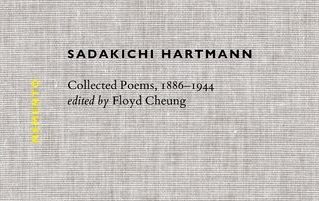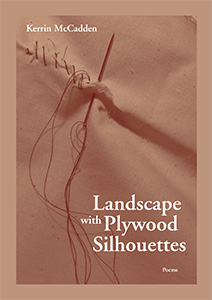Collected Poems by Sadakichi Hartmann, ed. by Floyd Cheung
– Reviewed by Afric McGlinchey –
Sadakichi Hartmann has been described as ‘one of the most intriguing and overlooked figures in the history of American poetry’ (Juliana Chang), and with this substantial volume, Dr Floyd Cheung sets out to recover what he considers a vital missing link in Asian-American literature. Sadakichi Hartmann, we learn, was born in 1867 on the island of Dejima, Japan, to a Prussian merchant and a Japanese woman who died soon after his birth. Thereafter, he was raised by a rich uncle in Hamburg. He was well known as an art critic (particularly championing photography as an art form), writer, performer and ‘bon vivant extraordinaire’. An audacious and fearless performer, he conducted olfactory ‘concerts’, which sometimes failed spectacularly, and drank ‘riotously’ with everyone from the Symbolist poets of Paris to the Bohemians of Greenwich Village to the movie stars of Hollywood. Ezra Pound is quoted as saying ‘If one hadn’t been oneself, it would have been worthwhile to have been Sadakichi.’
Cheung’s introduction portrays a personality similar to Rimbaud’s, intent on hedonism, milking every drop of pleasure possible. Hartmann experienced frequent asthma attacks, so when he was well, his motto was ‘carpe diem’. He discovered Walt Whitman’s Leaves of Grass in 1884 at the age of seventeen, and, thoroughly taken by him, visited the sixty-five year old to learn not just about poetry, but ‘how to be a poet’. The way he presented himself, the costumes and stance he adopted, were learned from Whitman. Theirs became ‘a deep if tumultuous relationship’, and Whitman’s influence can be seen in Hartmann’s use of natural and nautical images. Whitman said at the time, ‘I have more faith in him than any of the boys.’
Hartmann’s work blends Whitmanian imagery with Japanese aesthetics, although instead of Whitman’s leaves, Hartmann uses white flowers as a recurring symbol. Although he would wear a kimono when lecturing on a Japanese topic, Hartmann often said that he never thought of himself as a German or Asiatic: ‘Others do it for me.’ He also published under several pseudonyms; sometimes, Cheung tells us, ‘two personae appeared side by side in the same publication.’
With such a splendid introduction, I was anticipating exciting work. Hartmann’s style is rhapsodically romantic, often using formal register, flamboyant adjectives, sibilance and rhyme in his exaltation of the natural world (he often attempts a merging of the self with nature), or love:
Rose of love, be not ashamed of thy languid
grace, of thy trembling nakedness in the
sun’s embrace.For the kiss of ardent suns is thy life’s
desire and the flood of golden light feeds
thy wanton soul of fire.
–‘Poems to Eva’
Lush and often idealistic, his earlier ‘fruity, perfumed excesses’ are reminiscent of Whitman, and the exclamatory style evokes Baudelaire. Like Baudelaire, he is also cynical and jaded, after the initial rose-tinted idealization of the love-object has worn off; all that is left is ‘…the monotonous labor of lust’ (‘Hours of Midnight’). Love, he realises, ‘is destined to doom, when passion / in starlit gloom spins in her sinister / loom the shroud for the joys of night.’ (‘The Courtesan’s Complaint’). Also like Baudelaire, his flowers are symbols with varying meanings.
In this 191-page collection, there are not many poems that resonate for me, but here is one that does, in which nature images evoke the evanescence of love, and the dissonance and rhyme are effective:
Why I no longer love thee?
Ask why summer has fled,
Why autumn is dead with its garnet glow,
Why the sea is gray and the sky is gray;
Why bitter gales o’er the salt flats blow,
Where the sea-fowl sport in ghoulish play
And the pods of the beach-pea stand withered
On the long-curved rifts of dream-torn sand;
Why the shore is scarred by time’s rough hand,
And ships that heel on wintry seas
Are wrecked on the ashen strand!
Having moved to Paris, Hartmann came under the influence of Symbolist and Modernist poets. Those he met (Ezra Pound, George Santayana and Gertrude Stein among them), had a significant impact, particularly his encounters with Stéphane Mallarmé and Paul Verlaine. From them, he learned to seek access to two different spheres: ‘the higher sphere of the mystical beyond, and the inner sphere of the self’. Their approach was to use ‘concrete images of the everyday world…as vehicles to the unseen.’ They also introduced him to the concept of synesthesia,which erupts frequently throughout his work: ‘through the meadows the sighs of her fragrance swept’ (‘Broken Lily’). This approach, he decided, ‘allows access to an infinite mysterious space beyond this world.’ Hartmann also flirts with the shape of the poem on the page, frequently slanting each line, and experiments with form. There are villanelles, sestinas, roundelays and pantoums, as well as numerous haiku and tanka, a form he is credited with introducing to an American audience.
Some lines are beautiful – ‘The day is sick with rain’ – but their effect is undermined when they are followed by trite rhymes and a surfeit of melodramatic metaphors that, to my contemporary ear at least, verge on the ridiculous:
Again lightnings of violence are flashing from
mountain to mountain of lust, as the eagle of
love is cleaving the clouds of amorous dust.(‘Mysterious Flirtation’)
Hartmann, like many of his contemporaries, was inspired by The Rubaiyat of Omar Khayyám, which set off an ‘Omar craze’ and triggered many imitators. Hartmann’s own version, ‘My Rubaiyat’, was revised numerous times – if Whitman could revise Leaves of Grass six times, so could he – and his 1916 version, strongly critical of war profiteering, advocates conscientious objection. Instead of a Preface to this publication, he writes a letter to a critic, claiming that ‘My Rubaiya’t will survive. ‘I possess the arrogance of conviction.’ Filled with ‘pictorial’ images, as he calls them, the messages are simple and accessible:
XXXI
So many do as others do,
They cannot rise from the green mould
With which their thoughts are overgrown.
For them no lotus petals blow,
They peevish bow to any yoke,
And mole-like dig beneath the ground.
More interestingly:
There grew flowers at the wayside –
They were mine. I did not cull them.
And the challenge at the end of stanza XXl:
‘Have you been loyal to anyone?’
He develops more optimistic notes, and mercifully avoids the overblown excesses of earlier imagery:
XXXIX
…The star realms opening at night
Tell us of other wonder worlds –
Somewhat didactic, his aphorisms are meant to appeal to chambermaid and intellectual alike, he tells his critic:
LX
‘…What you like best is best for you.’
There are many quotable lines in this 75-stanza poem, and in my view this is the enduring poem of his career, if only for its pleasing rhythm, rhyme and accessibility.
His arresting essay, ‘The Japanese Conception of Poetry (1904), included here, introduced Americans to the symbolism of word pictures and ‘pivot’ words (words with two meanings) that epitomize Japanese haiku, and Cheung claims that Hartmann was instrumental in flowering the American Imagist movement.
He was certainly ambitious. In one of his untitled poems, he writes: ‘If words of mine / Own strength to live / Centuries hence…’ Laughing at himself, he even writes his own obituary in poem form. But my overall impression is that, aside from ‘My Rubaiyat’ and the aforementioned essay, both of which may well survive, this collection has curiosity value rather than significant literary merit. Frankly, I would have been more intrigued to read a biography of the eccentric Hartmann, who a friend described as a blend of Mephistopheles and Madame Butterfly – his life would make for a compelling film. Nevertheless, Cheung’s careful compilation of Hartmann’s first ever collected poems, and his extensive, contextualised introduction to a fascinating literary hybrid, is to be commended, and is sure to attract a following.




